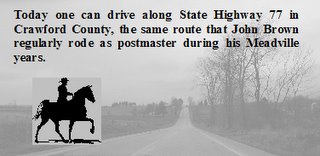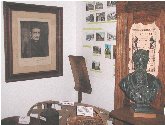Pennsylvania home

Brown students will recall that he moved his young family from Ohio over to this northwestern Pennsylvania community in his mid-twenties, where he established himself as a businessman, community leader, postmaster, and church founder in Crawford County. It was in the Meadville area that Brown buried his first wife, Dianthe Lusk, and two children, and subsequently married Mary Ann Day, his faithful wife who supported him in his later militant efforts as a freedom fighter until his death in 1859.


Notable from my tour was the Brown gravesite, the remnants of Brown’s tannery, and the nearby John Brown farm and museum owned by Gary and Donna Coburn. For research purposes, the archives of the Crawford County Historical Society are a rich resource on Meadville in Brown’s era, as are the John Brown papers, a small but notable collection in the Allegheny College Library. This collection includes some original Brown letters and copies of his extensive correspondence with his business associate, Seth Thompson. (The original letters to Thompson are held in the Atlanta University Library.)


As noted, Anne Stewart and Ed Edinger are important resource persons, not only for the John Brown story, but the history of their community. Stewart has written perhaps the definitive scholarly article on Brown’s Meadville years in The Journal of Erie Studies (Fall 2002), where she has made a detailed analysis of the period, 1827-36. The profile that emerges is of a conservative, orthodox, business-minded young man, not given to abolitionist organizations or the kind of militant activism that he later promoted in the 1840s in Springfield, Mass. (Incidentally, Anne has rightly scored me on a number of factual errors in my own chapter on Brown’s Pennsylvania years—the unfortunate result of depending on a less reliable scholarly article.) Stewart makes a strong and formidable appeal to the record and facts of Meadville’s history in her portrayal of Brown, and certainly takes issue with those who contend that his militancy emerged during this period. While I continue to believe that Brown engaged in some justice-oriented activism during this period, I must concur that the more outspoken, militant figure of later years had not yet emerged during the Pennsylvania period. Every reader is advised to contact the Erie County Historical Society (417 State St., Erie, Pa., 16501) and order this essential scholarly article.
Ed Edinger, along with Mark Peaster and other colleagues in the John Brown Heritage Association, have made notable contributions in The John Brown Newsletter, an excellent resource for students, scholars, and John Brown enthusiasts. Inquires can be made by writing to JBHA, c/o Ed Edinger, 291 Park Ave., Meadville, Pa., 16335.
Serious students are strongly advised to make their own sojourn to Meadville, Pennsylvania, to visit these valuable sites and deepen their research into Brown’s life. Perhaps John Brown’s Crawford County is no more, but the record and vestiges of this chapter are still rich and noteworthy.▪ (photos by L. DeCaro Jr.)
No comments:
Post a Comment